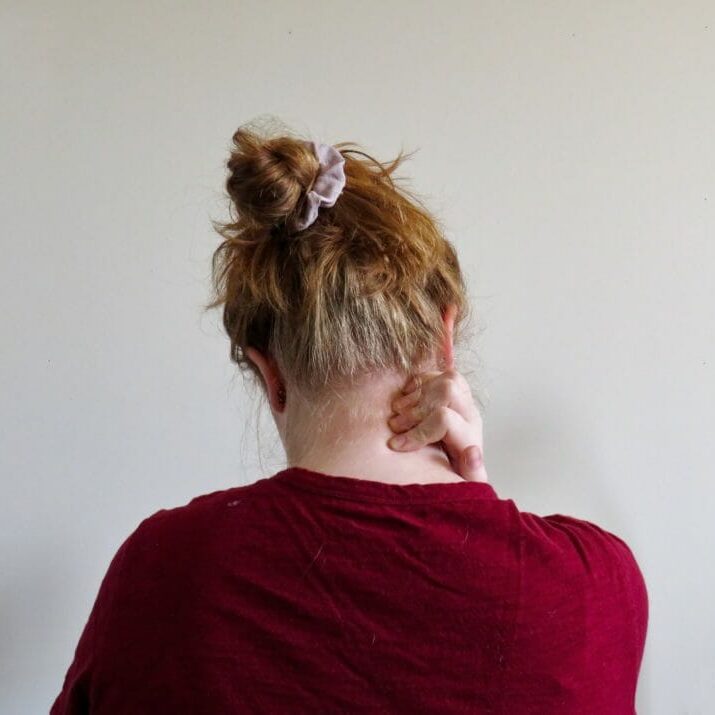
For some students at Dalhousie University, dealing with chronic pain is part of their daily lives. There’s no easy cure for it.
Drue MacPherson, a fifth-year Dal student, says her chronic pain started after an injury that occurred when she was 13. During a softball tournament, she tore a ligament in her ankle.
From 13 until age 20, MacPherson had ongoing pain and inflammation in her right ankle. And while the physical pain was bad enough, what made things worse was not being able to do the activities MacPherson loved.
“The only sport I’ve ever been fairly good at is tennis and at that age, I was trying to prepare to really take it on and go to national championships,” said MacPherson. “I really wanted to dedicate myself to the sport.
MacPherson had to quit playing because of her pain.
The pain continued for years, and when she got to university, MacPherson found many daily functions difficult.
“Just getting up to go to meal hall was so
Although MacPherson says she’s always had a good support system at home, it didn’t help that her friends and professors would sometimes not take her pain seriously.
“Over time, a weird resentment started to build up and some [friends] thought I was full of crap,” she said. “I also found it was very frustrating having to tell professors [about the pain] because it sounded like bullshit excuses that they’d heard often.”
MacPherson says doing years of physiotherapy helped in the long-term to rebuild strength in her ankle. The treatment she felt gave her the best immediate results was acupuncture, a traditional Chinese practice of stimulating parts of the body with needles to relieve pain.
“It made such a huge immediate significant difference,” MacPherson says.
Luckily for MacPherson, her pain did eventually go away, but says she still feels “a lot of anguish reflecting on a lot of the things [she] didn’t get an opportunity to do.”
What is chronic pain?
Chronic pain is distinct from acute pain and persistent pain. Acute pain occurs because of a specific injury or disease; this pain should go away after an injury is healed.
As Dr. Jana Sawynok of the Dal pharmacology department describes it, persistent pain, as the name indicates, is a kind of pain that “persists, but in time it resolves.”
She gives surgical pain as an example of this.
“There’s a major physical trauma to the body,” she said. “But that resolves over time. You know what’s causing it, so resolution takes place.”
Chronic pain, on the other hand, is a long-term pain that lasts for more than 12 weeks and “persists beyond when tissue healing occurs,” says Sawynok.
With chronic pain, central sensitization occurs in the central nervous system (CNS). As Sawynok explains, this is when the pathways in the CNS that signal the pain are modified and will continue signalling even after the stimulus that originally caused the pain is gone.
Complementary and alternative medicine
Like MacPherson, many people with chronic pain will turn to complementary and alternative medicine (CAM) to use alongside standard medical treatments to deal with their pain.
Sawynok has studied different types of CAM for chronic pain but has particularly focused on qigong.
“Qigong comes out of traditional Chinese medicine,” says Sawynok. “It has a long history of a couple of thousand years.”
Sawynok says qigong and the more well-known practice of tai chi fall in the same category of meditative movement. This differs from physical exercise which involves strength, flexibility and aerobic fitness.
Practicing qigong (pronounced “chi-gongh”) is about “cultivating qi,” says Sawynok. It’s difficult to translate and understand what exactly qi (pronounced “chi”) is. Sawynok describes it as “a mysterious word that comes out of Chinese practice.”
But the meaning of qi isn’t necessarily what’s important.
“The point is,” says Sawynok, “when people undertake these movements to cultivate qi, you can actually sense this dimension to how the body functions.”
Sawynok collaborated with clinicians to publish a trial in 2012 that tested the effects of qigong on a group of 100 patients with fibromyalgia, a syndrome that causes pain throughout the body. Because of the positive results of the trial, the pain management unit at the Queen Elizabeth II hospital has started offering qigong as a complementary treatment for patients with chronic pain.
Sawynok says that practicing qigong takes time and commitment, but it’s something people are willing to turn to when medical care like physiotherapy and drug therapies only prove to be limited in their efficacy.
“That’s part of why people turn to complementary and alternative practices,” says Sawynok. “They’ve only gotten partial efficacy from the current approaches that they’re using; and they want to ask: ‘Is there something more I can explore to augment that efficacy?’”
A student life with chronic pain
For Breanna Ching, a Dal student in her first year at the School of Social Work, managing her chronic pain involves physiotherapy, massage therapy and medication.
“I grew up with pain and I thought it was a normal human experience to go through until I was 19-years-old,” says Ching.
It was at this age that Ching was diagnosed with a rare genetic condition called Ehlers-Danlos syndrome. The name refers to a group of connective tissue disorders that result in many joint dislocations and joint pain.
“I find it difficult to keep up with housework, to clean and to cook,” Ching says. “I find it difficult sometimes to get to class, to sit in class –– my lectures are three hours long.”
For Ching, talking to the Student Accessibility Centre at Dal and getting accommodations was integral for her in figuring out how to manage her pain during the school day.
“One of my accommodations is that I’m allowed to go for frequent walks [during class] to lessen the strain of my muscles just sitting for a long period of time,” says Ching.
According to Quenta Adams, the director of the Accessibility Centre, there are many accommodations the centre can provide for students with chronic pain.
When a student requests for accommodations, they meet with an advisor at the Accessibility Centre to come up with an accommodations plan. Adams says these accommodations can include, “deferred exams, assignment extensions, note-taking, [and] priority access for parking.”
Adams says the Accessibility Centre can also work as a kind of middleman between students and their professors, letting their instructors know what accommodations they need without disclosing the student’s identity or health condition.
“We try to both advocate for the student but also coach the student to develop their own self-advocacy skills,” Adams says.
At the end of the day, living with chronic pain is a reality that students like Ching will have to face for years to come. Although there might not be a simple solution for the pain, Ching aims to look at the bright side of her situation.
“I’ve definitely grown to accept that [chronic pain] is a part of my identity and I’m reclaiming it as part of my positive identity,” says Ching. “Yes, I am Breanna. I am a lot of things, including having a chronic illness.”
Ching doesn’t want people to look down on her because of her illness. “Don’t pity me because I can’t do what you can do,” she says, “celebrate what I can do with me.”






